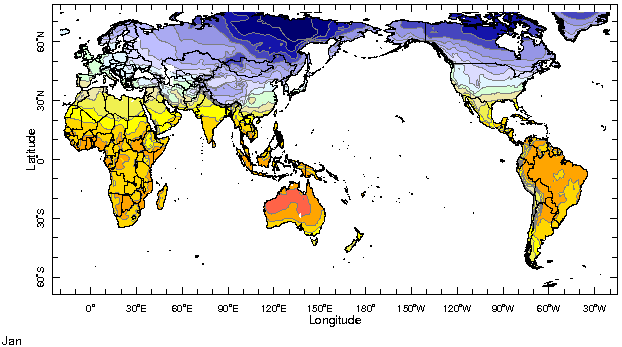|
IRI Climate Digest
February 2002
January Global Climate Summary
Climatological Background
In January, mid-summer monsoon systems are usually at their peak in the Southern Hemisphere over southern Africa, Australia and Indonesia, and South America. In the Northern Hemisphere, deep winter has set in, with strong north-south temperature differences driving the mid-latitude jet stream and storm systems.
Monthly Mean Temperature (1961-1990), data from the Climate Research
Unit, University of East Anglia


Monthly Mean Precipitation (1961-1990), data from the Climate Research
Unit, University of East Anglia


Temperatures
Below-normal temperatures in southeastern Europe and Turkey provided evidence of the winter storm that arrived in early January. Otherwise, temperatures were well above average over most of Eurasia and North America. Western Australia continued to see below average temperatures for the month.
Asia: Although extreme northern and eastern Russia experienced very cold conditions, most of the remainder of continental Asia, with the exception of Turkey and the Indian subcontinent, was much warmer than normal.
North America: Temperatures over most of North America were once again well above normal, especially in the northeastern and Midwestern United States, Alaska, and the Yukon Territory of Canada. Parts of Quebec, Labrador, and Newfoundland fell to slightly below-normal conditions, ending a long string of very warm months.
South America: Near- to slightly above-normal temperatures prevailed throughout South America.
North and West Africa: In conjunction with warm coastal SSTs, temperatures along the western Atlantic coast of North Africa were once again slightly above normal while parts of Niger, Chad, Libya, and Egypt were unusually cold for January.
Europe: More severe winter weather in January dropped temperatures in southeastern Europe, but the remainder of the continent generally exhibited warmer than average conditions.
Australia: Areas of western and southern Australia were again colder than average in January.
Temperature Difference from the 1961-1990 mean, with data
from NCEP Climate Prediction Center, CAMS.


Precipitation
Dry weather continued throughout much of Europe and the Mediterranean coast of North Africa while Japan, and areas of central Africa and eastern Brazil were quite wet.
Central America and Caribbean: Although only modest rainfall usually occurs in Central America and the Caribbean during January, drier-than-normal conditions were observed.
South America: Unusually dry weather prevailed in Bolivia and northern areas of Chile, Argentina, and Paraguay. Rainfall in much of Ecuador and northern Peru was also below average. Much of eastern Brazil received plentiful precipitation during the month.
North America: Dry conditions continued in the Northeast, the upper-Midwest, and northern Great Plains of the United States and in Quebec and Labrador in Canada.
Africa: A vigorous cold front during the middle of January brought unusually heavy rain to northern Senegal. Rain was lacking in a swath across southern Africa from northern Namibia and southern Angola eastward to Mozambique and northern Madagascar.
Southwest Asia: In spite of the heavy rains that caused flash flooding in Iran, and reports of rain and snow in Afghanistan, much of Southwest Asia remained dry.
Australia and New Zealand: It was drier than normal in much of northern and eastern Australia and in southern New Zealand.
Precipitation Difference from 1961-1990 mean, with data
from NCEP Climate Prediction Center, CAMS-OPI.


Oceanic Conditions
Tropical Pacific: The above-average sea surface temperatures (SSTs) seen in the central equatorial Pacific Ocean during recent weeks strengthened and expanded eastward in January. While near-neutral conditions persisted in the eastern Pacific, subsurface observations indicate that a shift towards conditions favorable for the development of an El Niņo is occurring. Above average SSTs began to emerge along the west coast of South America near the end of January with further warming likely in the coming weeks. Whether this situation will evolve into a full-fledged El Niņo is still unclear, but the situation bears close watching. Please see the latest IRI ENSO Update for a detailed summary and outlook.
SSTs across most of the Indian Ocean remained above average in January, although there was some cooling in southern parts of the basin. With the exception of some slight strengthening of warm SSTs off the coast of West Africa, there was little change in the equatorial Atlantic Ocean.
Mid latitudes: The warm SST anomalies in the southern Pacific Ocean strengthened considerably in January. There was some cooling in the center of the North Pacific and the eastern South Atlantic, but SSTs remained above normal in the North Atlantic Ocean.
Monthly Sea Surface Temperature Difference from the 1950-1979 mean,
with data from the Environmental Modeling Center, NCEP/NOAA.


Contents |
Special |
Impacts |
Climate |
Forecast
|

